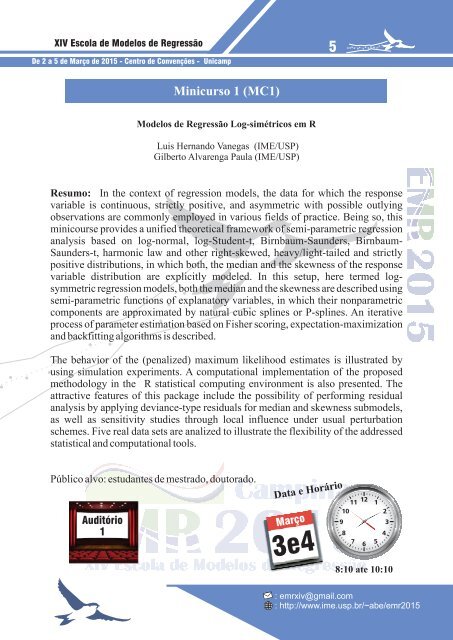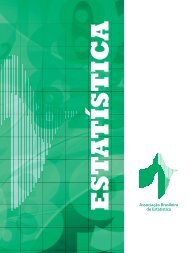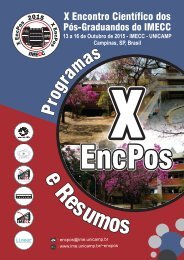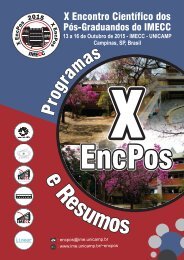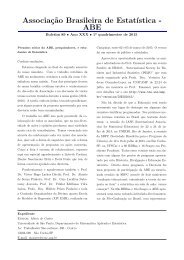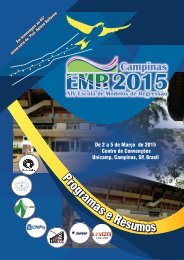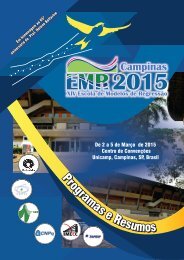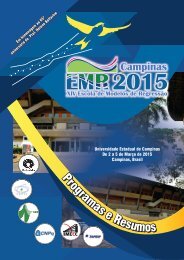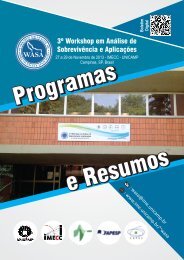Boletim do resumo e programas (XIV EMR 2015)
A Escola de Modelos de Regressão (EMR) é um evento científico na área de Estatística, de repercussão nacional, realizado com o patrocínio da Associação Brasileira de Estatística (ABE) que, em 2015, se encontrará em sua 14ª edição.
A Escola de Modelos de Regressão (EMR) é um evento científico na área de Estatística, de repercussão nacional, realizado com o patrocínio da Associação Brasileira de Estatística (ABE) que, em 2015, se encontrará em sua 14ª edição.
Create successful ePaper yourself
Turn your PDF publications into a flip-book with our unique Google optimized e-Paper software.
<strong>XIV</strong> Escola de Modelos de Regressão<br />
De 2 a 5 de Março de <strong>2015</strong> - Centro de Convenções - Unicamp<br />
5<br />
Minicurso 1 ( MC1)<br />
Modelos de Regressão Log-simétricos em R<br />
Luis Hernan<strong>do</strong> Vanegas ( IME/ USP)<br />
Gilberto Alvarenga Paula ( IME/ USP)<br />
Resumo: In the context of regression models, the data for which the response<br />
variable is continuous, strictly positive, and asymmetric with possible outlying<br />
observations are commonly employed in various fields of practice. Being so, this<br />
minicourse provides a unified theoretical framework of semi-parametric regression<br />
analysis based on log-normal, log-Student-t, Birnbaum-Saunders, Birnbaum-<br />
Saunders-t, harmonic law and other right-skewed, heavy/light-tailed and strictly<br />
positive distributions, in which both, the median and the skewness of the response<br />
variable distribution are explicitly modeled. In this setup, here termed logsymmetric<br />
regression models, both the median and the skewness are described using<br />
semi-parametric functions of explanatory variables, in which their nonparametric<br />
components are approximated by natural cubic splines or P-splines. An iterative<br />
process of parameter estimation based on Fisher scoring, expectation-maximization<br />
and backfitting algorithms is described.<br />
The behavior of the (penalized) maximum likelihood estimates is illustrated by<br />
using simulation experiments. A computational implementation of the proposed<br />
metho<strong>do</strong>logy in the R statistical computing environment is also presented. The<br />
attractive features of this package include the possibility of performing residual<br />
analysis by applying deviance-type residuals for median and skewness submodels,<br />
as well as sensitivity studies through local influence under usual perturbation<br />
schemes. Five real data sets are analized to illustrate the flexibility of the addressed<br />
statistical and computational tools.<br />
Público alvo: estudantes de mestra<strong>do</strong>, <strong>do</strong>utora<strong>do</strong>.<br />
Data e Horário<br />
Auditório<br />
1<br />
Março<br />
3e4<br />
8:10 ate 10:10<br />
: emrxiv@gmail.com<br />
: http://www.ime.usp.br/~abe/emr<strong>2015</strong>


